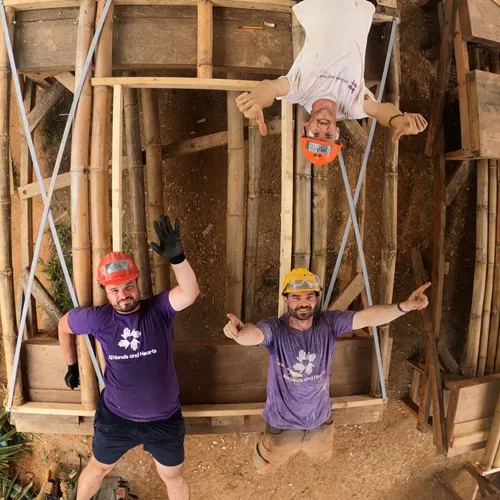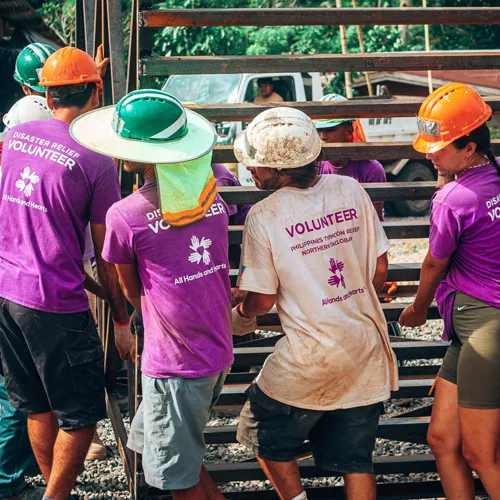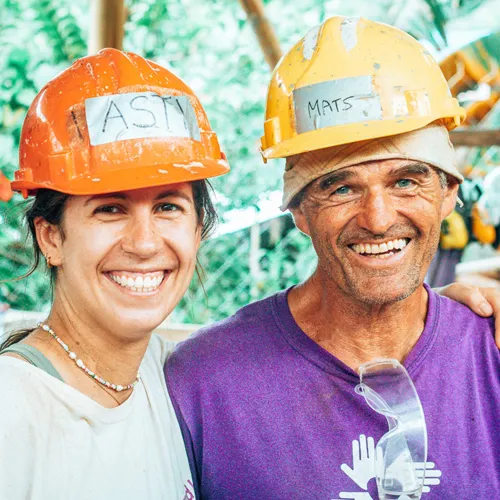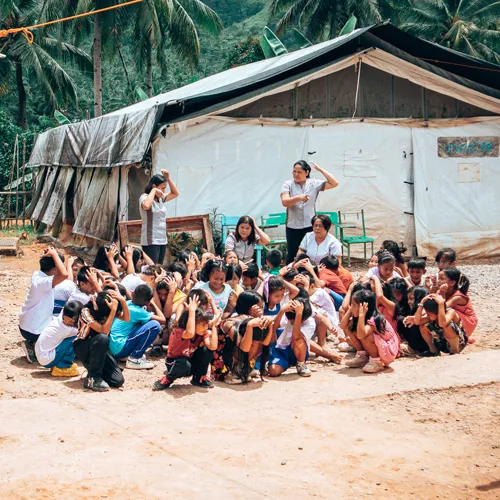Philippines Typhoon Relief
January 2007 – March 2025
Last updated: March 2025
All Hands and Hearts (AHAH) has intermittently operated in the Philippines since 2007, responding to disasters such as Typhoon Rai (known locally as Odette), Typhoon Haiyan (Yolanda) and Typhoon Mangkhut (Ompong). Our work is tailored to the unique needs of the disaster-impacted communities we work alongside. Primarily, this takes the form of restoring access to education by rebuilding typhoon-affected schools and constructing Transitional Learning Spaces (TLS). In Araceli, Palawan, this took the form of restoring livelihoods through facilitating fishing boat repairs led by an entirely Filippina team.
From May 2024 to March 2025, we launched the latest phase of our typhoon relief program, where we mobilized volunteers to work alongside local community members to help rebuild two schools in Southern Leyte.
Our Work
Our latest program in Southern Leyte provided safe and healthy learning environments for students affected by Typhoon Rai. With our local partner Base Bahay, the team successfully constructed a disaster-resilient building with two classrooms at Mahayag Elementary School, as well as a new building with four classrooms, and two additional learning spaces built with Amakan, a local sustainable material, at Sto. Nino High School. Mahayag Elementary School received a new playground and Water, Sanitation, and Hygiene (WASH) facilities, including accessible toilets and handwashing stations. Sto. Nino High School received access to clean drinking water for the first time through a new biosand filtration system, a 2,000-liter water tank and seven drinking taps. Both school communities participated in Disaster Risk Reduction (DRR) trainings and WASH and Child Protection sessions, attended by students, teachers, parents and community members.
Current Activities
Constructing With Sustainability
AHAH is committed to using environmentally conscious and durable building practices wherever possible when rebuilding after disasters. Our school rebuild projects in the Philippines utilize Cement Bamboo Frame Technology, an innovative, disaster-resilient construction system. Sustainability and endurance are the core features of CBFT, which provides livelihood to farmers while benefiting the environment. The strong root network of bamboo stabilizes soil and water tables. Remarkably, bamboo reaches structural grade in just three to five years, making it an efficient and renewable building material. Its use in construction has a significantly lower carbon footprint compared to conventional systems.
Additionally, buildings made with bamboo offer a more comfortable indoor climate, reducing energy consumption during occupation. Bamboo structures have remarkable resilience, standing strong against
Disaster Profile
The Philippines is one of the most typhoon-impacted countries globally, with roughly 20 impacting the region annually. Typhoons, known as tropical cyclones and hurricanes in other parts of the world, are among the deadliest disasters.
Super Typhoon Rai, locally known as Odette, made landfall on December 16th, 2021, bringing torrential rains, violent winds, floods and storm surges to the Visayas and Mindanao Islands. The typhoon caused devastating impacts on infrastructure, agriculture, and fishing communities and damaged or destroyed 1.7 million homes. An estimated 9.9 million people were severely affected, leaving about 2.4 million people in need of assistance and 408 fatalities.
Southern Leyte was one of the worst-affected provinces. Out of 528 schools, 312 of them were severely impacted. Rai destroyed 522 classrooms and damaged over 1,500.
Program History
Philippines Typhoon Relief
January 2007 – March 2025
Last updated: March 2025
All Hands and Hearts (AHAH) has intermittently operated in the Philippines since 2007, responding to disasters such as Typhoon Rai (known locally as Odette), Typhoon Haiyan (Yolanda) and Typhoon Mangkhut (Ompong). Our work is tailored to the unique needs of the disaster-impacted communities we work alongside. Primarily, this takes the form of restoring access to education by rebuilding typhoon-affected schools and constructing Transitional Learning Spaces (TLS). In Araceli, Palawan, this took the form of restoring livelihoods through facilitating fishing boat repairs led by an entirely Filippina team.
In May 2024, we launched a new phase of our typhoon relief program, where we are mobilizing volunteers and working alongside local community members to help rebuild two schools in Southern Leyte.
Our Work
Our newest program in Southern Leyte aims to provide safe and healthy learning environments for students affected by Typhoon Rai. With our local partner Base Bahay, the team successfully constructed a disaster-resilient building with two classrooms at Mahayag Elementary School, and is completing a new building with four classrooms at Sto. Nino High School. Mahayag Elementary School received a new playground and Water, Sanitation, and Hygiene (WASH) facilities, including accessible toilets and handwashing stations. Both school communities are participating in Disaster Risk Reduction (DRR) trainings and WASH and Child Protection sessions, attended by students, teachers, parents and community members.
Current Activities
In the final stretch now, AHAH teams made significant progress on our second school reconstruction project, building on the successful completion of Mahayag Elementary School. We are finalizing construction for the disaster-resilient classrooms at Santo Niño High School and installed a Biosand Water Filtration System, enhancing access to clean water and providing training to ensure its sustainable use. Additionally, 102 students received practical training from the Philippine Red Cross, enhancing community preparedness for first aid scenarios and future disasters.
Constructing With Sustainability
AHAH is committed to using environmentally conscious and durable building practices wherever possible when rebuilding after disasters. Our school rebuild projects in the Philippines utilize Cement Bamboo Frame Technology, an innovative, disaster-resilient construction system. Sustainability and endurance are the core features of CBFT, which provides livelihood to farmers while benefiting the environment. The strong root network of bamboo stabilizes soil and water tables. Remarkably, bamboo reaches structural grade in just three to five years, making it an efficient and renewable building material. Its use in construction has a significantly lower carbon footprint compared to conventional systems.
Additionally, buildings made with bamboo offer a more comfortable indoor climate, reducing energy consumption during occupation. Bamboo structures have remarkable resilience, standing strong against
Disaster Profile
The Philippines is one of the most typhoon-impacted countries globally, with roughly 20 impacting the region annually. Typhoons, known as tropical cyclones and hurricanes in other parts of the world, are among the deadliest disasters.
Super Typhoon Rai, locally known as Odette, made landfall on December 16th, 2021, bringing torrential rains, violent winds, floods and storm surges to the Visayas and Mindanao Islands. The typhoon caused devastating impacts on infrastructure, agriculture, and fishing communities and damaged or destroyed 1.7 million homes. An estimated 9.9 million people were severely affected, leaving about 2.4 million people in need of assistance and 408 fatalities.
Southern Leyte was one of the worst-affected provinces. Out of 528 schools, 312 of them were severely impacted. Rai destroyed 522 classrooms and damaged over 1,500.
















